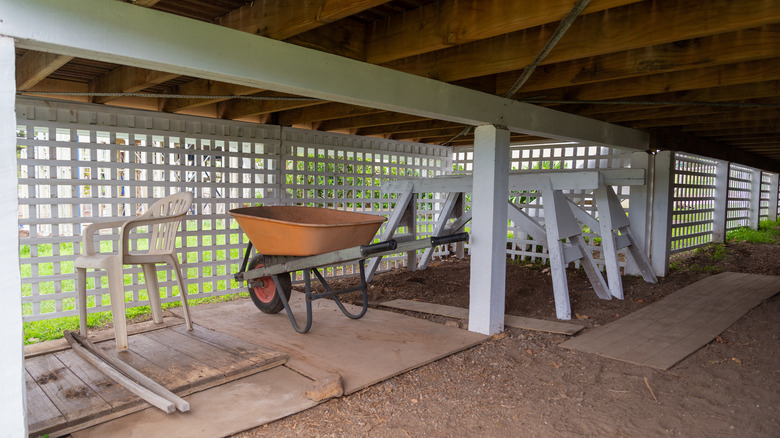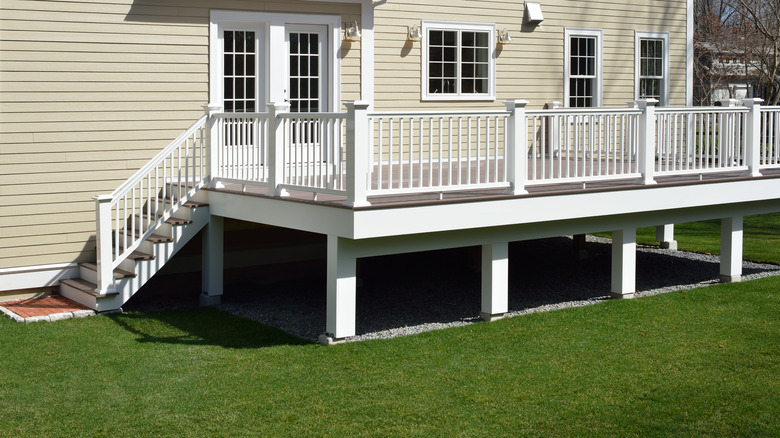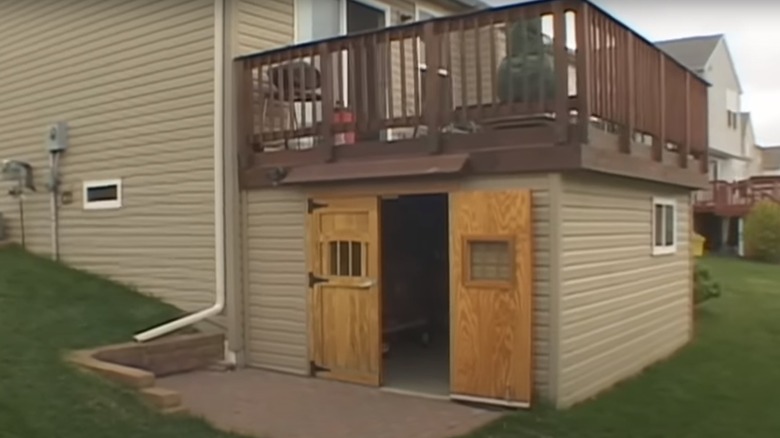The Best Way To Waterproof Your Deck For Underside Storage
Having a raised deck gives your home extra gathering space that you can use for relaxing and entertaining. But what's even better than building the perfect deck is making the most of the space underneath. Thankfully, creating under-deck storage space is easier than it may seem, and it all starts with adequately waterproofing the area. The best option is to add materials underneath the deck that prevent rainwater from leaking through. But you don't want to add materials that could sag, like a plastic tarp, or ones that soak up water, like untreated plywood or cardboard. These methods simply won't divert the water safely. Instead, stick with firm panels that hold their shape when damp and withstand the elements.
You can hang panels on the exposed wood beams and support posts underneath to prevent rain from draining through flooring slats and toward your storage area. The panels catch the rain and move it toward a gutter system, ensuring that you divert water away from your home's foundation. Excess water near the foundation can cause leaks in your basement or even result in your foundation shifting.
If you want to make a faux shed to store the mower, backyard toys for the kids, or gardening tools, keeping everything protected from the weather is the key to the perfect under-deck storage space. Consequently, you may also want to hang panels to enclose the open space to keep wind-blown rain and snow at bay.
How to waterproof below your deck
Bring a level underneath the existing structure and figure out which way you want the water to drain. Except for very unusual circumstances, you should always move the water away from the house. Next, use the level to determine if the deck has a natural, adequate slope away from the property. If not, you will need to add spacers or shims that create one. Creating a slope of up to 1 inch for every 4 feet of length is recommended, ensuring water will flow in the correct direction. By selecting a corrugated panel with materials like tin, fiberglass, or plastic, you will have natural channels as part of the panel's design.
Once you have spacers in place to ensure an appropriate water flow, you can screw the fiberglass, tin, or plastic into the frame on the underside of the deck. Use rubber washers with deck screws to stop leaks. If the deck has support posts in the way, you'll have to cut the material to fit around them. If you require multiple panels, overlap them a bit to ensure there are no leaks. If you receive a lot of rain, use a gutter at the end to catch the water. Otherwise, you can let it drop onto concrete or blocks on the ground.
Enclose the area under the deck
Consider enclosing the space to maximize protection for the items underneath your deck. However, because the panels used to create the enclosure may be easily visible to your neighbors, you should consider using higher-grade materials than what you discreetly used underneath the deck. An inexpensive option would be fence boards or thin decking boards, as they'll look good and have a weather-resistant design. Some people hang siding over the boards to complete the look. That said, depending on the configuration of the support structure for the deck, you may have to add more support posts or other pieces of framing. These give you a place to screw the fence boards or other materials to enclose the space.
Screw these items into the framing or support posts to enclose the space. Place them tightly together to ensure it's difficult for rain or snow to penetrate through gaps. You can add a door that attaches to the frame with hinges to fully enclose the space. You could even add a padlock for added security. Otherwise, leave a small section of the underside open for easy access. However, make sure the door or entryway is large enough for whatever items you plan to store.


